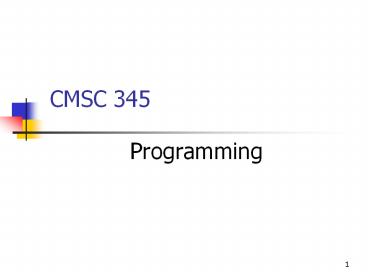CMSC 345 PowerPoint PPT Presentation
Title: CMSC 345
1
CMSC 345
- Programming
2
Topics
- Work Breakdown
- Coding Standards
- Defensive Programming
- Structured Programming
- Documentation
3
Work Breakdown
- Be positive that all component (e.g., objects,
functions) interfaces are crystal clear to all
team members - Based on these interfaces, divide the work into
independent, manageable pieces among team members - One team member in charge of configuration
management and change control wrt interfaces no
changes w/o his/her approval - One team member in charge of code
checkin/checkout and file directory structure - One team member in charge of integration
planning, keeping abreast of any changes in
interfaces and/or source code files (above)
4
Work Breakdown (cont)
- One team member charge of tracking that everyone
is doing what theyre supposed to do and is on
schedule should be in daily contact with all
team members - One team member in charge of master copy of SRS
and keeps track of changes, informing others of
changes - One team member in charge of master copy of SDD
and keeps track of changes, informing others of
changes
5
Coding Standards
- Everybodys got them - a very real-world thing
- They help you organize your thoughts and avoid
mistakes - They let you focus on the problem
- You must organize, format, and document your code
to make it easy for others to understand
6
Coding Standards -Problems Without Them
- Computer programs are generally more difficult to
read than to write (even one's own code is often
difficult to read after it hasn't been looked at
for a while). - Software that is not internally or externally
documented tends to be thrown-away or rewritten
after the person that has written it leaves the
organization (it is often thrown-away even if it
is documented).
7
Coding Standards -Problems w/o Them (cont)
- It is often more difficult to reuse software
someone else has written than to rewrite it your
self because it is hard to figure out how it
works. - In practice, debugging often takes the place of
understanding how programs work (ie., if we all
understood perfectly how our own code worked we
would not need to debug it to find out why it is
not doing what we think it should).
8
Your Coding Standards
- Establish team coding standards immediately and
document them - file header comments
- function and/or object commenting
- coding and commenting styles
- identifier naming conventions
- Later code inspections will check for this as
well as correctness - Makes easier to debug/maintain, particularly by
others not the original author nor even
original team members
9
Defensive Programming - General
- Check validity of all input parameters (e.g.,
within range, non-null) - Check validity of all returned values (i.e., from
called subroutines) - Repeatedly check validity of all external and
internal data structures or data files - Segregate this code so can easily be commented
out during performance tuning (if tuning is
necesssary)
10
Defensive Programming -Validate All User Inputs
- Expect the unexpected - and be able to recover!
- Respond to bogus inputs with useful diagnostics
when possible, and explain what would be valid
input in each case - When there is a default value, indicate in the
prompt and accept blank input to defer to the
default value - When there is a choice among a small number of
simple values, list all of them in prompt
11
Defensive Programming - User Outputs
- Clearly explain all user output along with the
output value(s) - Provide options for at least two levels of
verbose and terse output modes (also applicable
to prompts) - Probably also testing/debug mode (for use by test
drivers or scripts) - If the user has to wait, give a periodic visual
cue that the program is busy working (rather than
hung) - When possible, trap fatal errors and give
diagnostics (including how to recover and who to
report bug to)
12
Structured Programming
- Regardless of the programming language, each
program component involves at least - Control Structures
- Algorithms
- Data Structures
13
Control Structures
- Keep them as top-down as possible - no spaghetti
code - Are a good clue as to when a comment is needed
14
Algorithms
- Keep them as generic as possible (for reuse
within same program or with later program(s)) - Fast code is overrated and has cost (its
complex!) - Takes more time to write
- Takes more time to test
- Takes more time for users to understand
- Takes more time to modify and debug
- Execution time is only a small part of the cost
equation. Balance execution time with design
quality and customer requirements - DO NOT sacrifice CLARITY and CORRECTNESS for speed
15
Documentation
- Internal Documentation
- External Documentation
16
Internal Documentation
- Intended for a programmer-type reader
- File header comments
- Component (e.g., objects, functions) header
comments - Component body comments
- Local data documentation
- Meaningful variable names
- Formatting
17
External Documentation
- Intended for non-programmer-types (maybe those
who never read code) - Describe the problem addressed by the component
when invoked why needed - Describe the algorithms rationale, formulas,
boundaries, special conditions - Describe the data component level data flow

